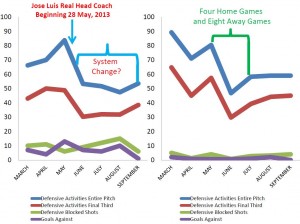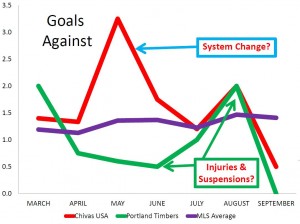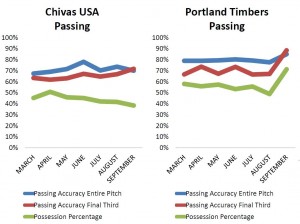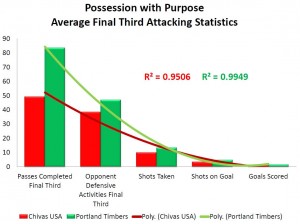Changes in Chivas will require different channel of attack for Timbers
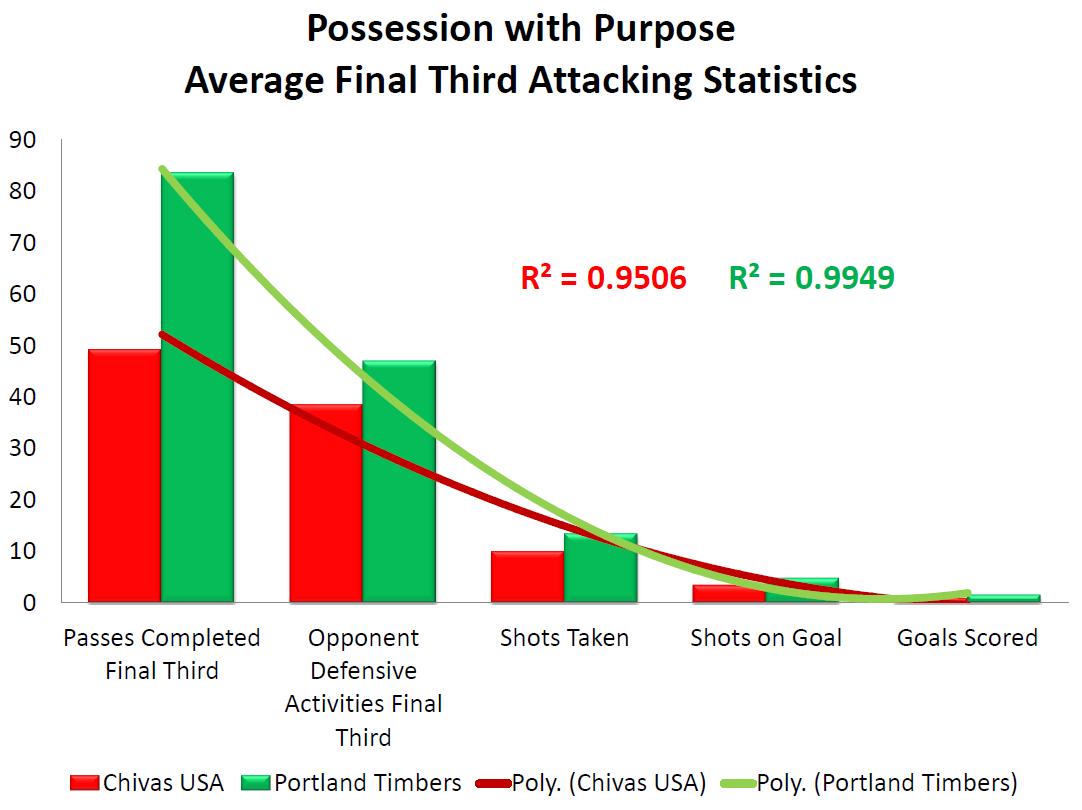
Portland Timbers travel to LA this weekend and play the “other team” who’s not quite as successful this year as the Goat Parade would like.
Before digging into a few pre-match trends of Chivas and Portland here’s some answers that Matthew Hoffman provided (SB Nation The Goat Parade) to some questions I sent him earlier this week…
Question #1 – What are three changes in the systematic approach between the previous head coach and the new one?
- The biggest shift Jose Luis Real has made since his June 19th debut would be the switch from a three-man back line. He shifted homegrown Marco Delgado to leftback to create a four-man defense. Some of the top leagues in the world utilize a three-man backline so it’s not a terrible idea. Chivas USA just never really had the personnel or really the inclination to make it work. Matthew Doyle of MLS did great video explaining the 3-5-2, as Chivas deployed it, deficiencies:
- Here’s that short video on Real from Matt Doyle MLS Soccer.com…
- The team dynamic was influenced by the coach and his temperament. In Chelis you have this motivational, fiery guy. Chelis wanted to dispossess opponents “eight seconds or less”. It seemed like a reasonable idea, but the end result wasn’t a good, or even average defense. Instead it was the MLS equivalent of the ’76 Philadelphia Flyers.
- Real has a cooler head; he’s a more cerebral, open-mind coach. Forgive me if this sounds like someone you know, Real’s not wedded to a certain formation.
- At first Real thought a Route 1,”kick and rush” approach might work well for the team. But he also wanted holding midfielders Edgar Meija and Oswaldo Minda in the game. He tried a 4-2-3-1 setup, which just doesn’t really work for that style of play. That is, kick the ball up field, hope your single striker can track and maintain the ball–often with as many as six defenders in the vicinity–until the Calvary (Cavalry) arrives.
- I honestly don’t know what the difference between a holding 4-4-2 or 4-2-2-2 (other than that one is much easier to write) but that seems to be the default for now.
- Real will make changes on the fly as well. In this past week D.C. United’s Nick DeLeon was getting the deep in the right flank. It took fantastic separate saves from Dan Kennedy and Carlos Bocanegra to keep DC off the board. Real made a tactical substitution in 27th minute withdrawing a striker which nullified DC’s scoring chances until the match’s dying minutes.
Question #2 – What is the most dangerous midfield/striker ‘combination’ (pairing) for Chivas?
- That’s a tough one. We have a very young lineup (average age of 24 years). But also Erick Torress, who has to be part of that tandem, has only been the Chivas USA for nine games. Just that in those nine games, he scored in seven goals.
- The offense performs better when Torres is paired up top with Julio Morales but my answer would be Bryan de la Fuente. There’s an asterisk there in he’s only been with the club for five games.
- De la Fuente is actually a product of Chivas USA academy and actually played on the first team (albeit for five minutes) in 2010. He took the opportunity to play in Mexico but it didn’t really work out for him. Returning to MLS after being away for three years he scored his first professional goal on August 21st– the day after he signed with the Goats.
Question #3 – So how much “grist” has Bocanegra really added to the Chivas Defense or has his presence been more window-dressing than anything else?
- Grist. What a great term! I confess I haven’t seen Boca play live. When you’re bound watching the game on tv chances are you aren’t going to see a central defender in a very flattering light.
- That said, on the year: Chivas USA has a negative goal differential of -21 (27/48). Carlos Bocanegra’s plus-minus is -1 (9/10).
- Obviously the defense isn’t that great. Goaltender Dan Kennedy leads the league is saves and shots faced. The Chivas defenders are so often caught out of position, to be chartable, that Boca has taken it upon himself to be the fireman.
- He’s not at 100% either. He’s presently battling through a heel contusion. He’s still recovering from a fracture in the same foot (right).
- I’m looking forward to him having a full season to recover.
My thanks to Matt Hoffman and the Goat Parade for some superb answers that should help others have a better understanding…
In considering Jose Luis Real I thought I would be together this diagram that speaks to the overall Dispossession with Purpose tendencies of Chivas and Portland (by month) as the year has progressed…
Observations:
- Note that the system change brought in by Real has dropped the overall averages on defensive activities (entire pitch – blue bar) within and outside the Final Third (Red bar).
- In this diagram it seems to indicate that Chivas have dropped a bit deeper and taken a slightly less aggressive approach in defending outside the final third.
- And while that may not have translated to lower goals against compared to March or April the trend does seem to indicate a tougher team to score on.
- As for Portland – there is a considerable trough between the end of may and early July that (seems?) to indicate a slight change in approach based upon playing more away than at home?.
- Part of this trough (may?) also have to do with National team call-ups, injuries and/or suspensions.
Perhaps this diagram will help clarify how those personnel changes may have impacted the Timbers goal scoring?
Observations:
- It would appear there is a clear drop in goals scored for Portland (green bar), working from June through to July, and then altering course as August came and went.
- Again this may be down to National call-ups but I’m more inclined to believe it’s more down to injuries and suspensions in the midfield and back-four more than anything else.
- In looking at Chivas it would appear that their ability to score goals has improved since Real was brought on board – note the red bar trend line increasing from month to month (September does not represent a whole month).
- The purple bar is provided for context so that you can see the MLS average Goals For…
So how about the defensive side of things and Goals Against… any trends there?
Observations:
- Again, it seems pretty clear that the change in system with Real coming on board the Chivas USA (red bar) team has changed and (barring August) has continued to reduce their goals against.
- With this being a home game it is likely they will be pretty stingy in their back-four and could even look to play a counterattacking style similar to their approach against New York a few weeks ago.
- Chivas had just 43% of possession yet came away with a 3-2 win.
- With respect to Portland (green bar) – injuries and suspensions have probably taken more of a toll than National team call-ups but the stable is strengthening and increasing in diversity.
- I hadn’t commented to much on Urruti coming on board but it was clear to me, through watching training sessions, that Dike was not going to stay with this team much longer.
- That’s not a diss on Bright – he is a smart guy who understands the game and the nuances; he’s just not got the right skill base to fit into a rotating and revolving 4-3-3 like others.
- Part of a strong management team is helping players fit elsewhere when they don’t fit in your own scheme – it’s that approach that may help convince other players to move here when they don’t fit elsewhere.
Two more diagrams before some closing comments; first up Passing Accuracy…
Observations:
- While it’s not as clear here I would offer that Chivas has improved their Final Third passing accuracy (red bar) but at the same time they have also sacrificed possession time on the ball (light green bar).
- For me that translates to a team that is playing deeper and looking to counterattack against teams that over-commit.
- I didn’t see the New York game but it is likely they didn’t expect Chivas to be as dangerous on the counter as they were.
- With respect to Portland; the numbers haven’t really changed at all, throughout the year, and that speaks to some superb consistency in following the philosophy of Caleb Porter; they are a possession based team and they behave like a possession based team. And again, it’s really down to the individual players matching the system Caleb works to and not Caleb having to change his system given some players are not available.
- He did that once against Real Salt Lake and I don’t imagine that will happen again without further training and practice on running a more deceptive 3-4-3 in the back-three.
Next up is Possession with Purpose in the Final Third…
- I’m not sure there is a better graphic diagram that shows the complete contrast between these two teams.
- Clearly Portland should and probably will dominate this game (green bar).
- For the stats guys that relationship value (R2 = .9949) really doesn’t have much room to get any higher… consistency not just (on average) across the entire pitch but also, more importantly, within the Final Third is the hall mark of this team. From what I recall only Montreal have been more ‘killer’ in the Attacking Final Third than Portland…
In closing…
- More returns this week for the wounded warriors and national road warriors; if a team is going to get strong and hit a peak now is a good time to begin that climb to top performance.
- This should be a crackin’ good game and the bench should be full to the gills for Caleb to change tactics as the game progresses…
- For me, what individual players start shouldn’t matter now that the stable is stable – nuance, deception and flexibility will be needed and it shouldn’t come as a surprise to see Chivas try and bolt from the box in the first fifteen.
- Concentration in the back-four is and will always be critical.
- The addition of Urruti over the well-like Dike should provide huge upside to the flexibility that Caleb looks for in his attack but we have yet to see him play and I’ve not seen him at practice yet…. others have offered up views but I will wait till seeing the grist he provides on the pitch – for now simply to early to tell…
- I offered up that the last game was a must-win (not the must win you need with two games left and six points required) but a must-win in that everyone should expect the Timbers to go in and take three points and if they didn’t it was one of those games where you could look back and say… if we only won against Toronto – for me it’s the same here.
- For Chivas to challenge it is likely they will try the same approach as Toronto – look to create set-pieces as early and as often as possible.
- With Chivas shifting to a 4-4-2 from a 3-5-2 the middle may be a bit more open than the wings; but that doesn’t matter too much. Portland can penetrate any area with anyone of their six midfielders/strikers.
- Overall, with the high level of accuracy in passing by Portland, I wouldn’t expect to see Chivas close down too quickly, anywhere, expect inside their 18 yard box – diddling for the middle will be key to opening up Chivas and that might mean a couple of overlaps by the fullbacks to open up the middle a bit more.
- Hard to say whether Powell gets the start or someone else like Zemanski or Zizzo; but like last week I would not expect Porter to trot out there in a 3-4-3.
Next up my match analysis….

